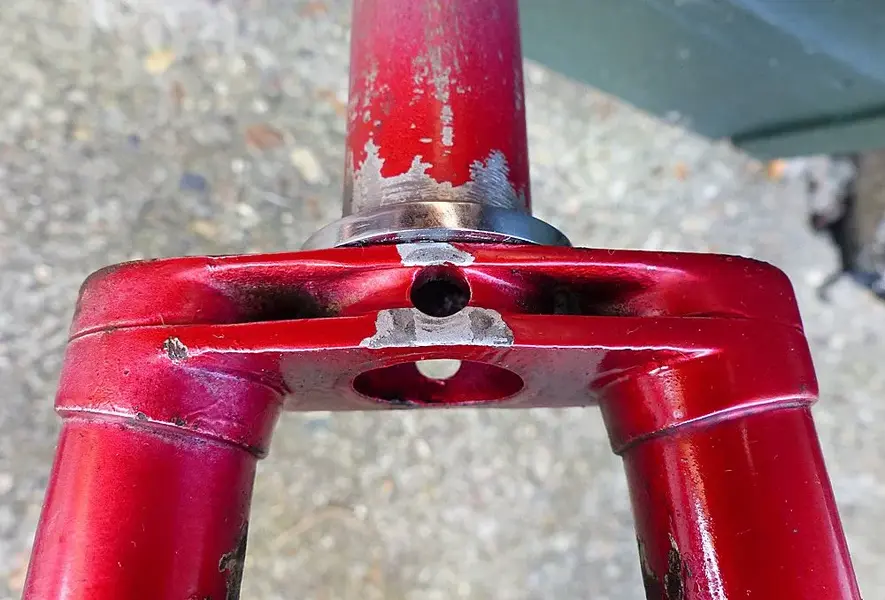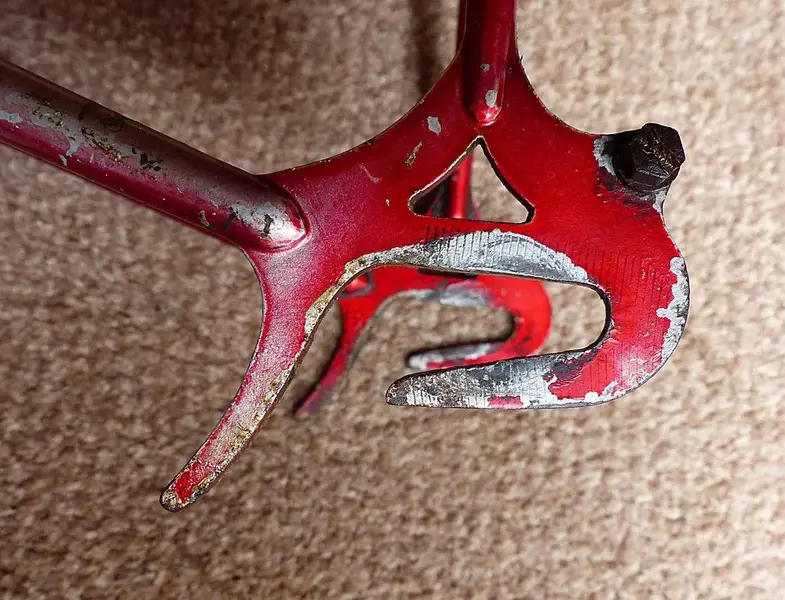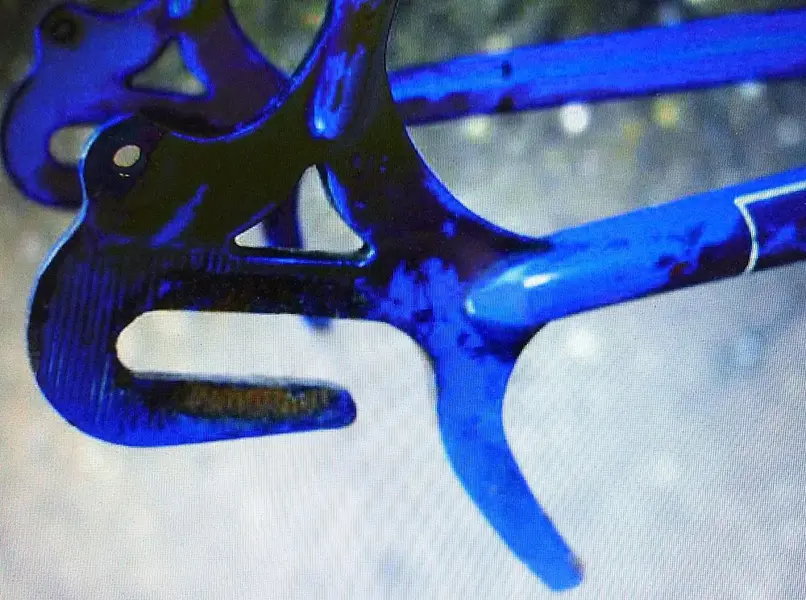You are using an out of date browser. It may not display this or other websites correctly.
You should upgrade or use an alternative browser.
You should upgrade or use an alternative browser.
Help identifying old Claud Butler
- Thread starter Losgaintir
- Start date
Losgaintir
Devout Dirtbag
Re:
I finally plucked up the courage to remove the stem, front forks and steerer tube etc.
Several loose balls later and the serial number was revealed, 841852 the same as the frame, so good news there!
Interesting that the axis of the 1 is different to the other numbers, is it meaningful?
The next big job (for me) will be the removal of cotter pins and bottom bracket assembly.
I have had a bit of a dry run with cotter pins on an old 1970's Peugeot, so far spectacular, by my lack of success.
Are there any special tips, tools or wrinkles on getting these out cleanly and quickly?
Colin
I finally plucked up the courage to remove the stem, front forks and steerer tube etc.
Several loose balls later and the serial number was revealed, 841852 the same as the frame, so good news there!
Interesting that the axis of the 1 is different to the other numbers, is it meaningful?
The next big job (for me) will be the removal of cotter pins and bottom bracket assembly.
I have had a bit of a dry run with cotter pins on an old 1970's Peugeot, so far spectacular, by my lack of success.
Are there any special tips, tools or wrinkles on getting these out cleanly and quickly?
Colin
Attachments
Re:
Hi Colin,
some penetrating oil first and back the nut off but don't take it off of the cotter pin. Then you save the thread and don't bend it hopefully. A thin punch and a hammer can be used. There is a cotter pin removal tool and a few other ways but using a vice and nuts. Good to see the forks match.
Simon
Hi Colin,
some penetrating oil first and back the nut off but don't take it off of the cotter pin. Then you save the thread and don't bend it hopefully. A thin punch and a hammer can be used. There is a cotter pin removal tool and a few other ways but using a vice and nuts. Good to see the forks match.
Simon
+1 for a presoak on all metal to metal parts
Sheldon has some advice on cotter pins.
http://www.sheldonbrown.com/cotters.html
make sure you support the crank arm.
Sheldon has some advice on cotter pins.
http://www.sheldonbrown.com/cotters.html
make sure you support the crank arm.
Re:
In the 50s I had a cotter pin tool from Cyclo with an adjustable cam and handles about 18 inches long. This would squeeze the cotters in or out. I bought cotter pins in boxes of 1 gross (144), about £1.50 a box. British size is 3/8 inch.
The other method is very simple. Undo the nut up to the top of the thread. Take 2 small hammers, rest one on the top of the cotter, and hit it with the other, very rapldly. Light hammers will do.
If you imagine trying to hammer a punch held in you fingers close to the chainwheel you might see the sense of this. You fingers are about 12 inches away, and do not feel the shocks, so you can concentrate on the rapid hammering. Devise some way of supporting the bottom bracket.
Keith
In the 50s I had a cotter pin tool from Cyclo with an adjustable cam and handles about 18 inches long. This would squeeze the cotters in or out. I bought cotter pins in boxes of 1 gross (144), about £1.50 a box. British size is 3/8 inch.
The other method is very simple. Undo the nut up to the top of the thread. Take 2 small hammers, rest one on the top of the cotter, and hit it with the other, very rapldly. Light hammers will do.
If you imagine trying to hammer a punch held in you fingers close to the chainwheel you might see the sense of this. You fingers are about 12 inches away, and do not feel the shocks, so you can concentrate on the rapid hammering. Devise some way of supporting the bottom bracket.
Keith
Robbied196
Senior Retro Guru
Re:
Cotter removal is easy with a 12mm socket and a vice. I use a small vice in my hand rather than on a bench, a G clamp will work but a vice is better.
Wind the nut to the top of the thread, put the socket over the wide end of the cotter then clamp it all in the vice. Even the toughest cotters will wind out with no damage to them at all.
If you remember which cotter is drive and non drive side you can reuse them. Flip everything around so the socket is at the threaded end of the cotter and wind the cotters back in.
Cotter removal is easy with a 12mm socket and a vice. I use a small vice in my hand rather than on a bench, a G clamp will work but a vice is better.
Wind the nut to the top of the thread, put the socket over the wide end of the cotter then clamp it all in the vice. Even the toughest cotters will wind out with no damage to them at all.
If you remember which cotter is drive and non drive side you can reuse them. Flip everything around so the socket is at the threaded end of the cotter and wind the cotters back in.
Losgaintir
Devout Dirtbag
Re:
Back on October 23rd, Keith very astutely observed that the rear drop outs were probably distorted.
Rear wheel, etc. now removed and all is revealed.
Keith was quite correct, but what on earth could have caused this, as both sides appear identical
Images of my distorted ones in red, as they ought to be in Blue!
Colin
Back on October 23rd, Keith very astutely observed that the rear drop outs were probably distorted.
Rear wheel, etc. now removed and all is revealed.
Keith was quite correct, but what on earth could have caused this, as both sides appear identical
Images of my distorted ones in red, as they ought to be in Blue!
Colin
Attachments
A thicker axle was inserted?
Losgaintir
Devout Dirtbag
I don't think that they have been filed out, merely spread. A close comparison with the paralle sidedl Blue items, shows them to be near identical
Am I correct in thinking, that I have read somewhere, that these items are forged?
Colin
Am I correct in thinking, that I have read somewhere, that these items are forged?
Colin
Similar threads
- Replies
- 3
- Views
- 1K
- Replies
- 2
- Views
- 1K



